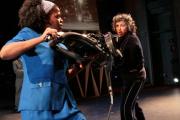UTOPIA/dystopia
UTOPIA/dystopia project activities engaged both long standing and new area residents of Skid Row--including the homeless and formerly homeless, the working poor, immigrants and their families, and the area's burgeoning loft-living population--in performances, art installations, and public events to inform and broaden the public discourse on development in the city of Los Angeles. In recent years, civic policy in Los Angeles has generated the twin towers of utopia and dystopia: Bunker Hill, the redeveloped high rise financial center, and below it Skid Row. A real estate boom generated new social policy, including the desired displacement of the majority population of poor living in the area. The Los Angeles Police Department, in defiance of the 9th Circuit Court of appeals ruling barring the criminalization of homelessness, has engaged in a policy of constant harassment and daily arrests of people living on the streets in order to "make the area safe for development." At the Roy and Edna Disney/CalArts Theater, LAPD created the performance UTOPIA/dystopia, which combined found texts--city council meeting minutes, Mayor Villagariosa's inaugural address, first-hand experience on the streets of Skid Row, and fiction--to articulate both the developers' narrative and the alternative community narrative. Other events reached the community in different ways. For the community performance pieces, 220 Glimpses of Utopia, LAPD involved 220 people from Skid Row, artists, and art students from around Los Angeles in envisioning and expressing what utopia looks like to them. Each group generated a movement sequence, with the resulting creation being a line of movement on the sidewalks that extended, unbroken, the ten blocks from the heart of Skid Row to City Hall. Every person in the chain contributed something of their own vision and movement, conveying that any true utopian vision (including one for the future of downtown Los Angeles) includes everyone and excludes no one. LAPD also created Glimpses of Utopia, performance/public conversation events that were specifically designed to spiral outward and bring more community members and groups into the curatorial process and construction of future events. LAPD invited some of the most widely recognized social visionaries from the Skid Row neighborhood--everyone from street vendors to a formerly homeless visual artist who became a loft dweller--to speak out about other people and initiatives that they valued. Another element of UTOPIA/dystopia was the visual arts exhibition, Skid Row History Museum, created at The Box Gallery. The exhibition included artifacts and installation elements from a variety of neighborhood-generated arts and political action initiatives, archival contributions (documents, photos, videos) from numerous neighborhood groups, and a visual timeline of the neighborhood from 1930 to the present.
